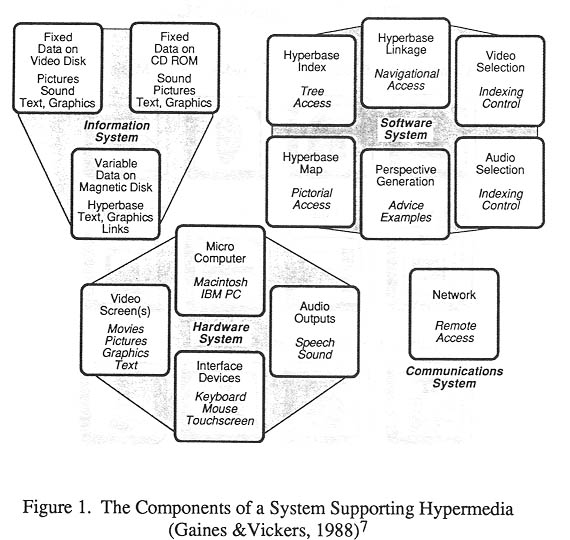
Ching-chih Chen
Simmons College
Boston, MA 02115
Abstract: The paper provides a quick summary of the historical development of the hypertext/hypermedia. It also discusses what is hypermedia in today's dynamic information environment, the potential problem with hypertext/hypermedia system, and the effect of new technological developments in recent months on hypermedia application. Finally, PROJECT EMPEROR-I, a hypermedia R&D project experimented on all major delivery system platforms is described, and the potential of this type of application for librarians, information professionals, and education media specialists is discussed.1. INTRODUCTION
During the last decade, there has been endless and dramatic technological changes in all three major areas of information technology - computing, communications, and content. We have witnessed the advent of personal computers, worldwide packet networks, optical disc and other mass storage media, interactive video technology, image technology, computer graphic technology, and the growth both in size and number of massive public and private databases - bibliographic first, then numeric, and now multimedia. These three major areas were rather disparate in earlier years. Yet, they are becoming increasingly integrated and quite international in scope and impact. There is every reason to believe that this situation will continue, perhaps at an even faster pace, for the foreseeable future. Thus, this is indeed an interesting time to witness the integration of all types of technologies -old, new, and some yet-to-come.
It is not possible to cover all areas of new technological advances in this paper. Instead, I shall devote the space mainly to the area of multimedia/hypermedia.
Since the introduction of Apple's HyperCard in late 1987, we seem to be entering a new chapter of hypertext/hypermedia information delivery. In a short eighteen-month period, there is a quantum surge of interest in hypermedia applications. Indeed, behind the complex and quite confused HyperWeb environment, instead of accessing, retrieving, delivering, and utilizing print-based information only, the technological environment is ready now for us to be very demanding and aggressive in seeking needed information which is available in all forms and formats. In other words, we want to access easily and quickly the massive amount of multimedia information as we think. We are in a hypertext/hypermedia age!
How this is possible? What is hypertext? What is hypermedia? What are the potential possibilities for using hypermedia in today's information environment? How can librarians and information specialists benefit from this development? In order to address these questions, let me start with a historical look on the development of hypertext and hypermedia, and then share with you experience gained from PROJECT EMPEROR-I, an R&D project in the use of cutting-edge technologies for hypermedia information delivery.
2. FOUNDATION AND DEVELOPMENT OF HYPERTEXT
In the early days when the first room-sized computers were being designed, only a few far-sighted thinkers understood where these thinking machines might take us. While George Orwell gave us one view of a world subjugated by leaders who had harnessed the power of the computer for their own selfish goals,1 positive vision of the future was offered by scientists such as Vannevar Bush, a former science adviserto Franklin D. Roosevelt. In his famous article entitled "As we may think" published in the July, 1945 issue of Atlantic Monthly,2 Bush projected that "information overload" would be a serious problem. It would beincreasingly difficult for one to keep up with the latest knowledge in any given field. He described his vision of a device called "Memex," an electronic desk that could access any text of linking files within seconds. Although Memex was never actually developed, the foundation for a system now known as hypertext was laid.
Bush's idea endured and inspired two people about twenty years later - Douglas C. Englebart of the Stanford Research Institute and Ted Nelson of Xanadu. Englebart, influenced by Bush's vision, developed a system for knowledge workers, called NLS (oNLine System). NLS embodied many original ideas and concepts of hypertext, including windows, the mouse,electronic mail, and a hypertext-like ability to link and annotate documents.3 Over the years NLS has evolved to become the information repository system, called Augment, for ARPAnet, and is accessible now via Tymnet/McDonnell Douglas. Nelson coined the word "hypertext" in the 1960's which he describes as non-sequential reading and writing which links different nodes of the text. His prophetic call-to-action for a personal computer revolution was published in his Computer Lib/Dream Machines in 1974 with an updated edition published by Microsoft Press in 19874 and Literary Machine in1981, with the 1981.1 edition published as the GUIDE Hypertext Edition for the Macintosh by Owl International Inc.5 He also presented his ideas in a paper entitled "As we will think" at the Online Meeting in 1972.
With the advent of computer technology specifically the powerful workstation in recent years, Engelbart's work and Nelson's hypertext theory have encouraged several other hypertext projects. Among them, the largest are NoteCards developed at Xerox PARC and Brown University's Intermedia.6 In addition to research projects, commercial software program such as Owl International's Guide was introduced in the first half of 1987, followed by the flexible, powerful but easy-to-use HyperCard, introduced by Apple in the second half of 1987. Both programs draw heavily on the hypertext theories.
2.1. What is Hypertext?
As already stated, hypertext refers to non-sequential reading and writing. A hypertext system allows users to link information together, thereby creating trails through associated materials. A link connects electronically words or sentences in one document/file to related concepts andinformation in another document/file. Linking related information items together is by no means a novice idea to librarians and information specialists. In a typical print-based source, we are very familiar with the frequent uses of cross references such as "See's" or "See Also's" under indexing terms, or citations such as footnotes or references at the end of each chapter of book or an article, to refer to more related information. For print-based sources, a reader has to flip pages back and forth or leap from one volume to another or use indexing tools in order to make the connections. But, for an electronic hypertext system, one is able to access any non-sequential reference in the files easily. Instead of reading from beginning to end, a good hypertext system encourages browsing and hunting.
2. What is Hypermedia?
Hypertext applications have thus far been limited to linking together textual/numeric information, and some small number of digital images. However, given today's computer technology, the logical extension is to contemplate the linking of all kinds of information sources. Instead of just text, users can link text, data, graphics, video, animations and voice together. Thus, hypermedia links textual material to all forms of material that may be digitally encoded for storage and retrieval through computer-based systems, including images, sound, graphics, and animation. Gaines and Vickers, in their introduction to hypermedia systems, illustrate the components of a system supporting hypermedia as shown in Figure 1.7 CasaBianca in his gallant

attempt to publish a hypertext-like journal, HyperMedia, graphically
presents a typological framework of hypermedia in what he calls HyperMedia
Map. He uses graphic icons, as shown in Figure 2, to illustrate how the
world's communications
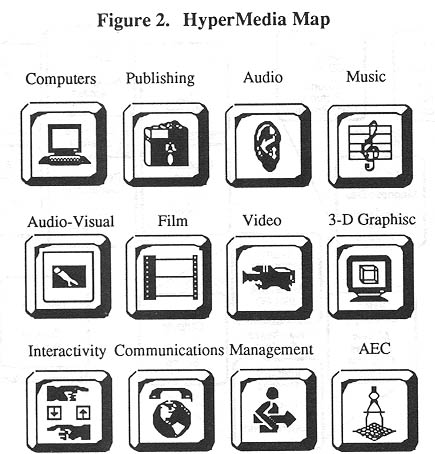
media - audio, audio-visual, film, music, video - have been incorporated with computers, communications network, publishing and information resources, 3-D graphics, design, and system management to enable us to provide multimedia/hypermedia information in a new, global, "wired society."8 Thus, when we talk about multimedia now, it refers to a synthesis of text, data, graphics, animation, optical storage, image processing, and sound. Clearly, multimedia technology is not a single technology, and there is no single product, or definable market. It epitomizes technology integration. In other words, it is a collection of technologies - some old, some new, and some yet to come - which are all integrated together to make the computers more powerful, but much easier to use and more relevant to the users' needs. Like pieces of puzzles fitting together, they make a story meaningful and a picture complete.9
As discused earlier, although the hypertext/hypermedia concept is not new, it was Bill Atkinson's HyperCard, introduced in the second half of 1987, which made it possible for one to have meaningful and easy trials of the hypertext concept. As to hypermedia, or interactive multimedia, most of the activities so far have taken place on the Macintosh and on the Amiga because of their built-in graphics and sound features. However, there is every reason to expect that this technology is to spread and spread fast to other delivery platforms.
3. NEW TECHNOLOGICAL DEVELOPMENT IN 1989
In the last eighteen months alone, we have witnessed increasingly more exciting applications which have employed many types of information technologies to provide not only text and data information, but also photograph-quality images, animation, good-quality sound, and more importantly, interactivity and connectivity. The array of technologies utilized include microcomputer and minicomputer technologies; optical storage technologies including CD-ROM, analog videodisc, WORM, and erasable; scanning and digitization, technologies; computer graphics; communications technologies; etc.
During the first quarter of 1989, there have already been many exciting developments. In the CD-ROM technology area, the rate of increase in both the number of drives installed and the number of CD-ROM products available continue to grow steadily. It is expected that a market platform for CD-ROM with an installed base of 1 million drives will be reached by 1990, as compared with only 171,000 drives in 1988. Many obstacles to acceptance of CD-ROM technology are being lifted. Prices of CD-ROM drives are dropping below $500 at the low end by the summer of 1989, and at the high end, adrive from Pioneer priced at less than $1200 is scheduled for late this summer which will permit automatic selection of any of six CD-ROM discs installed in the drive's jukebox. Drivers and interface cards which allow multiple devices from different manufacturers to be daisy-chained to a single SCSI adapter have been introduced. New products and techniques for pre-mastering and producing CD-ROM discs are also available to reduce entry costs for both software developers and CD-ROM database producers and vendors. One step of pushing CD-ROM technology to areas of multimedia is the introduction of CD-ROM Extended Architecture (CD-ROM XA) by Microsoft and Sony. This standard enables the inclusion of FM-quality audio together with a small video window on a standard CD-ROM.
Another exciting development has to be the co-development of Digital Video Interactive (DVI) multimedia products by IBM and Intel with Microsoft and IBM providing open standards, as announced in March 1989. DVI is a data-compression technology that enables one to store up to 72 minutes of interactive full-motion video and audio on a single CD-ROM disc. The initial steps in 1989 will include support for CD-ROM XA and DVI within Windows/386 and the OS/2 Presentation Manager, and thus will provide multimedia capabilities to the IBM compatible machines. It is expected that by 1990, Intel will have the entire development system on a chip set which can fit on the motherboard of a PS/2.
Also in the first quarter of 1989, availability of multimedia delivery capability with digital audio, real-time video, and fast 2-D and 3-D graphics was also announced for a number of powerful workstations such as the new Sun SPARC-Station 1. In addition, there are significant advances in various subsidiary technologies referred to as Multimedia. such as animation, desktop video for creating/manipulating video images and for producing in-house presentations, sound capturing and editing, 32-bit true color image creation and presentation, etc.
4. CAUTIONS ON DEVELOPING HYPERMEDIA SYSTEMS
As the widespread interest in developing hypermedia applications is
growing rapidly, it is essential to take heed of the warnings given by
experienced developers and producers in the field. It is important to realize
that the processing of linking multimedia information in a hyperweb environment
can be both confusing and disorienting. While hypermedia offers great potential
for instruction, information provision, education/training, and research,
one of the major problems facing the developers and designers of hypermedia
is the user-interface. Gaines and Vickers, in their excellent article on
design considerations for hypermedia systems, define a hypermedia system
as one which "uses advanced technology to facilitate interaction between
people and knowledge-related materials." To avoid the trivialization of
the term hypermedia through loose applications, they list the following
hypermedia functionalities:7
Essential Expected Desirable
. Integration
. Diversity . Programmability
. Freedom
. Extensibility . Orientability
. Flexibility
. Sociality . Guidability
. Usability
. Spatiality . Recreatability
. Attributability
. Communicability
The relationship between the designer/producers and their users is also stressed by CasaBianca. In his editorial of the HyperMedia's Premier Issue, he states that "beyond the many demanding technical elements that allow hypermedia to come together, there is a sense of transcendental phenomena that occurs during the production process. While combining massive amounts of information, one commonly observes coincidences and encounters baffling developments. Great care must be taken to separate the intelligent realities from the illusions..." Integrating the complex threads of interactive electronic communication requires an emphasis on the relationship between the designer/producers and their reader/listener/user/viewers. New access paths to source material and new procedures for protection and licensing must be developed. Industry standards must emerge to facilitate diversity and universal connectivity. Hypermedia shaping tools must help us share knowledge, express emotion and explore truth."
5. CASE PRESENTATION ON HYPERMEDIA APPLICATION - PROJECT EMPEROR-I
Having provided the above overview on hypermedia, a case presentation on a major R&D hypermedia application, PROJECT EMPEROR-I, will be given here. Since various aspects of this project have been reported heavily in both public media and literature, are available in a more than 20-page bibliography (with a great majority written by others), and reported in numerous international conferences around the world, the following will provide only a brief summary. Readers are also referred to one of the most recent articles on the project in Academic Computing 10. Given this paper's topic, heavy emphasis will be given on hypermedia information delivery, although this is only one aspect of a rather large project. Other project activities are summarized in Section 5.3. It is a kind of hypermedia application developed with considerable attention given to the essential, expected, and desirable functionalities listed under Section 4.
5.1. PROEJCT EMPEROR-I - What it is?
PROJECT EMPEROR-I: China's Treasure Revealed via Videodisc Technology, supported by the Humanities Project in Libraries, US National Endowment for the Humanities (NEH), started in late 1984. It started as an R&D project which applies the latest in hybrid microcomputer and videodisc technologies in presenting and interpreting one of the most important and early historical/archaeological periods in China.
The site and artifacts recorded and presented are from the period of the First Emperor of China, about 2,200 year ago. As the Roman Empire was expanding in the West, the First Emperor of China was conquering other warring states to create the Chinese nation. History knows this victor as Qin Shi Huang Di, . During his brief fifteen-year reign, his accomplishments included the implementation of a unified written script, the connection of strategic portions of the Great Wall, the unification of the various warring states, the standardization of weights and measures, the development of an extensive transportation system, and the building of his magnificent tomb at Mount Li near Xian. The site has long been recognized, but has not been excavated. In 1973, less than a mile from this mound, the 7,000 plus life-size terracotta figures of warriors and horses were discovered (Figure 3). This spectacular discovery is considered one of the most magnificent and significant archaeological finds in this century, and has captured the fascination of thousands and thousands of people all over the world.
5.2. Project Objectives
PROJECT EMPEROR-I is intended to bridge the gap between the East and the West, the past and the present, humanities and high tech, and scholarship and applications. New information technologies have the capability to deliver large amount of multi-media information quickly, easily, and differently from those available in more traditional sources. Because of this, PROJECT EMPEROR-I demonstrates convincingly that new technology indeed can be used to promote better general understanding and appreciation of the humanities. It also introduces a new interactive educational and learning model.10 This enables librarians, educational media specialist, teachers, professors, and researchers to create innovative humanities programs which achieve a new mode of public programming, education, and research in exciting and unexplored areas of the humanities; and provides students and the general public alike the opportunity to gain subject knowledge through accessing, enjoying, and digesting the online electronic multimedia information at their own pace and choice, and at the point of need.
Since the completion of "The First Emperor of China" videodiscs in the summer of 1985, PROJECT EMPEROR-I has attracted wide-spread interest and curiosity across disciplinary lines and target groups - general public and specialists in every field, young and old, etc. All project objectives have been achieved. In fact, due to the radical advances of the hybrid microcomputer and optical technologies, and their associated technologies such as computergraphics,scanning technology, etc. in the last four or five years, this project has moved far beyond the objectives and activities from what was originally expected and imagined in 1983-4.
5.3. Project Products and Activities
PROJECT EMPEROR-I is a technology integration project, which utilizes a combination of many technologies - new, old and hopefully those yet to come. Since it is an R&D project, it is not intended only for one type of delivery platform. Thus, the following major project products and activities will show that developmental work has been done or experimented on almost all delivery platforms - MS-DOS systems for IBM PC and compatibles, Macintosh, Sun mini-computer, Digital Equipment Corporation microcomputers such as Professional 350 and MicroVAX. As time goes on, some applications are no longer functional due to obsolecense. For example, while gaining invaluable experience in the development of prototype interactive courses on DEC IVIS, those applications have been superceded by our hypermedia applications on Mac II. The major products and activities include:
(1) The production of videodiscs - a set of two 12" NTSC CAV videodiscs, entitled "The First Emperor of China: Qin Shi Huang Di, " was produced in 1985;
(2) The development of interactive multimedia courseware for both general public and students and researchers. Developments in this area include:
. Prototype courses for DEC's IVIS systems
. Sample courses for IBM compatible PC systems
. Hypermedia applications on Macintosh, including the latest Mac IIs.
Both English and Chinese versions have been developed
. Multimedia application on DEC MicroVAX is being experimented in cooperation
with Project Athena at the
Massachusetts Institute of Technology
(3) The creation of electronic image databases . Using Image Concepts' C-Quest for IBM compatibles . Cooperating with SOPHIATEC of Nice, France in using SOPHIADOC for IBM compatibles . Using HyperTalk in developing in-house image database system for Mac II . Using Image Understanding System's OASIS Software for Sun Microsystems' Sun 3-160 minicomputer
(4) High-resolution image digitization and electronic imaging - This application is being developed on a Sun 3-160
(5) Converting/creating large textual files and scanning/digitizing images - Using MicroTek's MSF-300G image scanner, INOVATIC's optical character recognition software, ReadStar II Plus, and VersaScan software.
More details on these activities can also be found in the recent article in Academic Computing. Each of the above activities is developed to fulfill and/or demonstrate for a certain purpose. Although many of the project's major activities and products were not even included in the original proposal submitted to NEH in 1983, they have now become the major efforts of the project instead. This is all due to the dynamic nature of new technological development as described in the beginning of this paper. Undoubtedly, as new technology evolves, more new activities are expected to be forthcoming. Clearly, from the types of hardware and software mentioned above, PROJECT EMPEROR-I has integrated the use of all types of technologies whenever they are needed. These include both microcomputer and minicomputer technologies, object oriented software engineering, image technology, scanning technology, optical technologies - videodisc, WORM, and CD-ROM. In the following section, discussions will concentrate on the content of the project and how they are presented and interpreted to the users through interactive media technologies. In that, the hypermedia application on Mac II will be highlighted.
5.4. PROJECT EMPEROR-I'S Hypermedia Application
In addition to our earlier attempts to deliver multimedia information on DEC's IVIS, multimedia applications are being experimented at both DEC's MicroVAX under the MUSE system, and Sun 3-160. They are only beginning. DEC's MicroVAX uses a high-end microcomputer while Sun 3-160 is a powerful minicomputer. These system configurations are comparatively quite expensive when compared with PC-based systems and are really intended for high-end users who can afford more expensive systems.
In order to encourage those with less resources, PROJECT EMPEROR-I demonstrates convincingly that powerful, flexible and user-friendly hypermedia applications can be developed on less expensive delivery platforms such as Apple's Mac 512 and Mac SE. With the support of both the Multimedia Group and the New England Regional Office of Apple Computer, Inc., and thanks to Bill Atkinson's HyperCard, we have used HyperTalk to develop our own hypermedia interactive courses, under the general title "The First Emperor of China: A LaserDisc Guide", under the HyperCard environment. We have been able to take full advantage of the rich and enormously large multimedia information bank stored on the set of two videodiscs - moving video, still picture, audio in dual English and Chinese languages, music, descriptive text, primary expert commentary and interview sources - as well as the large textual and database information stored on microcomputer. For the first time, we are able to deliver any of the chosen multimedia information, as we think, at speeds not previously possible, generally no longer than half a second after we click the mouse on the chosen icon. It is a true seamless environment where, behind the transparent HyperWeb environment, a system user can gather and link information easily from different storage media and sources to obtain his or her own desired information package, without feeling the pain and frustration of searching for information or waiting to obtain them.
5.4.1. Modules
Figure 3 is the Home Card of our HyperMedia Guide which will open the door for us to the "knowledge base" on The First Emperor of China just like we are entering the entrance to the Museum of Qin Terracotta Figures of Warriors and Horses in Xian and can expect to see the grandeur of the magnificent terracotta army of the Emperor. As we click onthe arrow sign, the Main Index (or Contents of the knowledge base) will appear as shown in Figure 5. There are several modules, each of which can be accessed by a simple click of the mouse. The heart of our hypermedia application is our interactive multimedia courses which can be accessed at the following two levels:
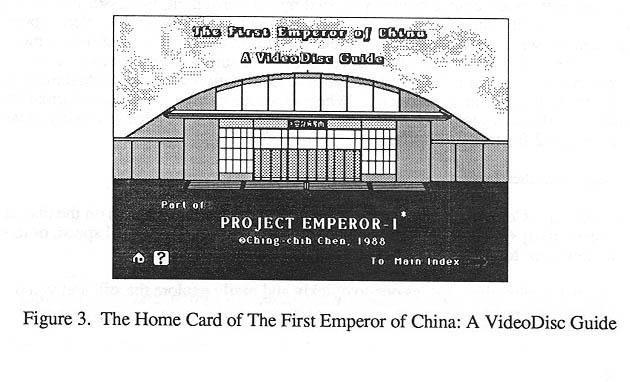
The General Information courses which are designed for the general public and school children. When a topic, for example, "Introduction to Qin Shi Huang," is clicked or chosen (see Figures 4 for menus in dual English and Chinese languages, which can be switched back and forth also at a click), the browser will take the system user immediately
Figure 4. The Main Menu in both English and Chinese Versions
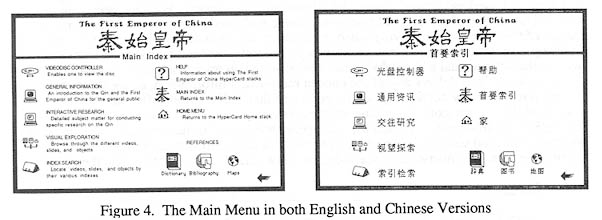
to a video card, and the relevant video will start immediately to provide a 5-minute introduction to the Emperor. As the video is going on, the system user is able to browse the textual information displayed on the computer monitor, manipulate the video showing, or to ask for additional information, such as an interview with a subject expert on the chosen topics, relevant slides on the subject, and additional textual information. In addition, one is able to either print or make notes on any thing as one thinks. (Figure 5)
Figure 5. The Videocard Showing the Video-controls, Text Icons, Actual Text of the Narration of the Video, Notepad, etc... on the Introduction to Qin Shi Huang
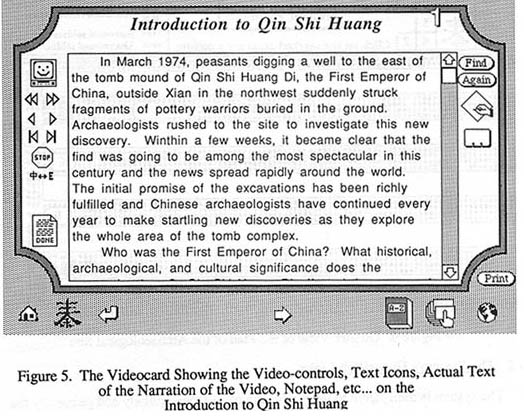
The Interactive Research module works in a similar way to that of the General Information module. The Interactive Research courses were modeled after an extensive two-semester graduate study course outline prepared by our consultant, Professor Robin D. Yates of Harvard University, the only Qin specialist in the country. They are intended to provide a student and/or researcher with much more detailed subject treatment on a chosen topic. Thus, the subject topical areas can have several levels of subdivisions. Each topic is presented with one, two or all of the three types of information sources - textual information, visual (slides or videos), and interviews. When slides are chosen, database information and descriptions of the slides together with information sources can be retrieved easily as well. See Section 5.4.2 for further discussion.
Aside from the above, there are several other useful modules as well:
. Videodisc Controller enables one to retrieve the visual information on the disc at Level I interactivity (this means that one is able to play the video at normal speed, or to scan faster or slower, or to go forward or backward one frame at a time).
. Visual Exploration enables one to quickly and easily explore the still and video images, and also obtain videos with zooming-in, zooming-out, and rotating effects.
. Index Search is essential for obtaining database, description, and related textual information on any given still image or moving video segment. There are six ways of searching - by date (of object or of discovery), by location (current location or discovery location), by type of material, by source of information, by subject, or by a combination of them. The Subject Index essentially maps out the hierarchical structure of the entire subject. Each subject concept can be further subdivided and/or described by a "modifier" or "descriptor." For example, the picture of a kneeling archer which is a close-up with front view is certainly different from that which has a back view and only the close-up of the upper body. In other words, our subject search system is designed and developed to enable retrieval of desired images with much greater precision and relevancy. Aside from these modules, commonly applicable to all searchable information are the "References" which can consist of all types of reference tools available in a library. We have chosen only three at this time for prototype development and demonstration. It is our believe that if three can work smoothly in the system, then any number of types of sources available in the library can be accommodated as well. These three types are:
. Dictionary
. Bibliography
. Maps
For Bibliography, not only relevant bibliographic citations are given, but also full text retrieval can be performed immediately, provided there is no copyright difficulty. For Maps, they are available from macro-geographical maps of an area to the plan of the site (see Figure 6), showing the line up of the 7000 terracotta figures, and images of any given part of the plan can also be immediately retrieved together with the associated information.
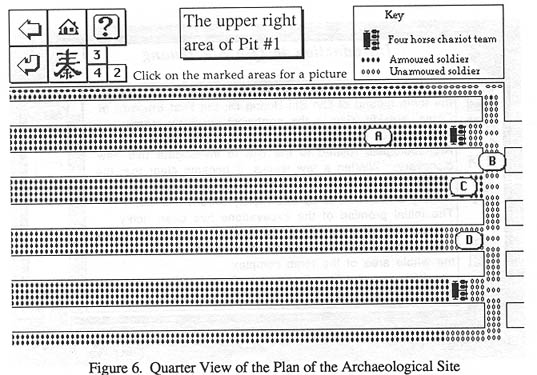
5.4.2. The System's HyperWeb Links
The system is transparent to users who can truly access quickly and
painlessly the massive amount of multimedia information, gathered and synthesized
together as shown from the icons of Figure 2 as included in Figure 7, as
deemed relevant and desired by them. We are indeed achieving the non-sequential
browsing, reading, and writing which Nelson envisioned. The simpler and
more user-friendly the system is for users, the more complex the links
among different nodes of texts, files, images, and audios are. Take the
Interactive Research module as an example, we have developed seven courseware
for the students and professionals in this subject field. The knowledge
base is arranged in a hierchical structure, with each broad subject topic
(which is considered a course in our project) further subdivided in numerous
sub-, sub-sub-, and sub-sub-sub- sections whenever appropriate. Thus some
topics many have five levels of sub-sections. Figure 7 shows the much simplified
links from one major subject topic to the other in using our hypermedia
system. When we go down one level of sub-divisions under topic, the complexity
of the HyperWeb links increases sharply as illustrated in Figure 8. One
can imagine what the web would look like when it is truly representative
of the current course structure with multiple levels of divisions under
each topic. Remember also that we are only discussing the Interactive Research
module, and the system has multiple modules, as described in Section 5.4.1,
which are all linked together in a cohesive way.
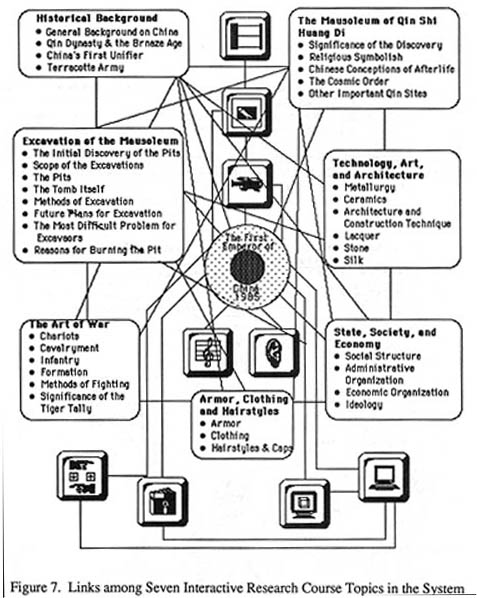

6. IMPLICATIONS FOR LIBRARIES AND INFORMATION CENTERS
PROJECT EMPEROR-I illustrates how new information technologies, when integrated together, can not only effectively present and interpret any subject topics, even difficult ones in the field of art history and archaeology such as the stunning site of the Emperor's terracotta army and horses, but also provide immediate access to multimedia information despite the various barriers such as time and geographical distance. It can also permit the free and immediate exploration of the fascinating ancient treasures which otherwise could only be viewed on site. Although this project is related to an art history and archaeological subject, the experience gained from the project in terms of an integrated use of technology for information-related problem solving, and the implementation process are transferrable to all subject fields, including science, technology and medicine.
PROJECT EMPEROR-I started with somewhat "impossible" challenges including the following major ones:
To develop a truly interactive multimedia system on a subject on which we had zero information. We had to collect every single piece of information, regardless of format, from ground zero;
To choose a subject topic, as fascinating as it is, which is very new, and information access is a real problem. This problem is compounded many fold also because of logistic reasons, such as governmental negotiations for information access, geographical distance, etc...
Yet, we were able to overcome these challenges, and our initial set of two videodiscs were produced, in an incredible time line and extremely small budget for a project of this scope and magnitude, in June 1985 - nine months from the starting date of the project. This set of videodiscs contains a large quantity of rich multimedia source materials, which form the base for all of our project activities as described in Section 5.3. Thus, it is a good demonstration to library and information professionals that should you ever be in the position to start any project similar to PROJECT EMPEROR-I, most likely your job would be lot easier, since you are unlikely to have to start collecting from scratch your information source materials, and you would not have to face the type of logistic problems which often are the most difficult ones to face.
Each activity/product of PROJECT EMPEROR-I has generated considerable interest and enthusiasm among librarians and information specialists who came to be in contact with it. Yet, the frequent remarks have been "it is definitely where the future is heading to, but it is too expensive and we cannot afford it now." These types of comments miss the essence of what we are trying to impart. Thus, it is worthwhile to stress the following:
PROJECT EMPEROR-I is an R&D project. Although we are happy to report that we have received permission from the Chinese authority, who has cooperated with us, to distribute our videodiscs, that was not our project objective. As an R&D project, we did not have a product in mind, and we want to experiment in all areas, if possible, which are generally considered as either "difficult" or "impossible", regardless whether there are problems related to content, technology, finance, and operations. PROJECT EMPEROR-I demonstrates that these can be overcome, but we are not advocating that librarians should all start projects such as ours.
. PROJECT EMPEROR-I also presents a philosophy on information access and delivery. As discussed earlier, technologies are available for us to consider hypermedia information delivery, which goes far beyond the traditional ways of delivering print-based information only. There are many media sources - videodiscs, CD-ROM products, etc. - available in the market place which one can incorporate in libraries and information centers for more dynamic ways of information provision and delivery. These products are available for either only about $100 to a couple of thousand. In fact, some sources with dynamite information are available either free or at incredibly low cost. For example, when PROJECT EMPEROR-I's "The First Emperor of China" discs become available for distribution (in a couple of months), the price will be only a couple of hundreds of dollars since the project is supported by US NEH and is not commercial. The Multimedia Group of Apple Computer, Inc. has just produced its Visual Almanac videodisc which includes multimedia information on almost all subject areas covered in a school's curriculum - history, language, social science, science, astronomy, animal kingdom, politics, international subject, art, etc. Several thousands of images from The First Emperor of China disc are also included. This disc, together with exciting HyperCard applications, is to be given free to every American school system with a Macintosh facility. American's well-known NOVA programs on animal kingdom etc. are to be jointly published by WGBH Foundation and Apple Computer, Inc. on videodiscs with HyperCard applications as well. The well-known Louvre Museum artifacts are available on videodiscs with HyperCard applications from the Voyager. All these are priced in the range of a couple of hundreds of dollars. One further point to be made here is that the growing awareness of school children of these cheap products and their desires to subsequently use them, will place an increasing burden and pressure on library and information professionals.
Technologies are tools to enable us to enhance information access. Thus, we should learn how to use them effectively, rather then being used by them, depending on the information-related problem at hand - some big and some small. Thus, a simple project utilizing simple new information technology and techniques is not necessarily less inferior than a fancy and elaborate technology project. The purpose determines the value of a given project, not just the types of technologies used. In a small library or learning resource center, there are many small-scale projects related to information needs, in which you will find hypertext/hypermedia applications not only relevant but also most productive.
7. CONCLUSION
PROJECT EMPEROR-I's integrated use of new information technology has provided researchers, students, and the general public with a dynamic system for immediate access to multimedia information. As an R&D project, it thrives in the current HyperWeb environment. In the short four-year period, it has evolved to many activities and projects which were not even included in the original proposal submitted to NEH in 1983. "This is because we are dealing with cutting-edge technologies which are indeed moving targets. Standing on a fast moving sidewalk, we see new technological tools come and go swiftly. Thus technologies are not really important. The overriding concern should be whether we are able to utilize the available new technological tools effectively to enhance information access. PROJECT EMPEROR-I has demonstrated that every individual's information need, regardless whether s/he is researcher, scholar, student or layman, is important and deserves our consideration. Thus, we have developed various R&D products to meet the diversified needs of information seekers. In order to maximize the potential use of these products, they are also developed for multiple delivery platforms."
"PROJECT EMPEROR-I is a good example to show that one can develop a
project which can stand the test of time without the danger of obsolescence.
With the rich source materials - stored either on videodiscs, in machine-readable
forms on computer tapes or hard disks, or in hardcopy formats - we shall
continue to build on what we have now and expand the scope beyond it. Undoubtedly,
we shall utilize whatever new evolving technologies and techniques there
are to enable us to broaden our horizon. Thus, in a very confused and exciting
technological environment, we view the future with great enthusiasm. The
future holds great promise for information professionals!"10
REFERENCES
1. CasaBianca, Lou, "Ted Nelson: Hypermedia magician," HyperMedia Premier Issue: 23-25 (Summer 1988).
2. Bush, Vannevar, "As we may think," Atlantic Monthly :101-108 (July 1945). Also reprinted in CD-ROM: The New Papyrus. S. Lambert and S. Ropiequet, eds. Redmond, WA: Microsoft Press, 1986.
3. Smith, Karen E., "Hypertext - Linking to the future," Online :32 (March 1988).
4. Engelbard, Douglas C., "A conceptual framework for the augmentation of man's intellect," in Vistas in Information handling. Vol. 1. London: Spartan Books, 1963. 5. Nelson, Theodore H. Computer Lib/Dream Machines. 1974. Revised edition. Redmond, WA: Microsoft Press, 1987. 6. Nelson, Theodore H. Literary Machine. Published by the author, 1981. Ed. 1987.1 (Guide Hypertext Edition for the Macintosh). Bellview, WA: Owl International Inc., 1987.
7. Gaines, Brian R. and Joan N. Vickers, "Design considerations for hypermedia systems," Microcomputers for Information Management 5 (1): 1-28 (March 1988).
8. CasaBianca, Lou, "HyperMedia Map," Hypermedia Premier Issue: 5 (Summer 1988).
9. Chen, Ching-chih, "Multimedia technology is here: Not just a buzzword in 1989!" Microcomputers for Information Management 6 (1): Editorial (March 1989).
10. Chen, Ching-chih, "The First Emperor of China's ancient world uncovered:
From Xian to your electronic screen," Academic Computing 3 (7): 10-14,
54-56 (March 1989).